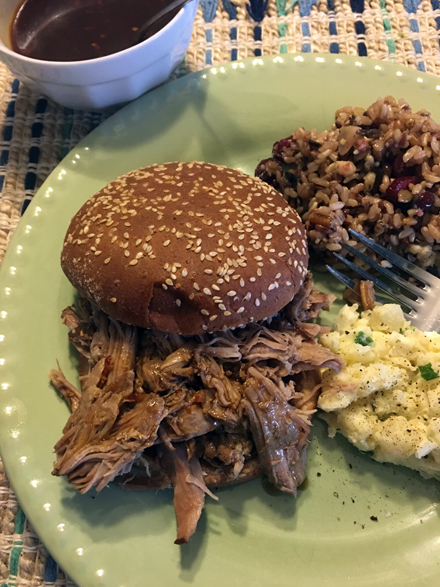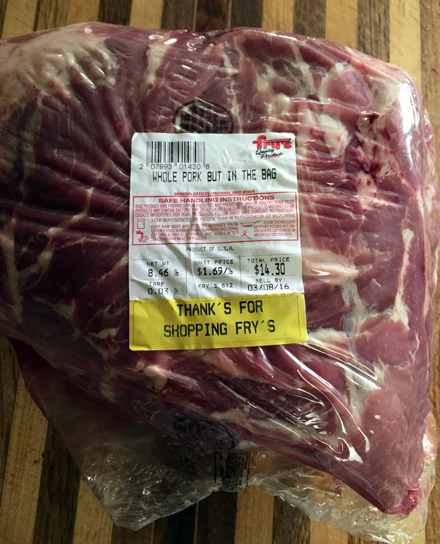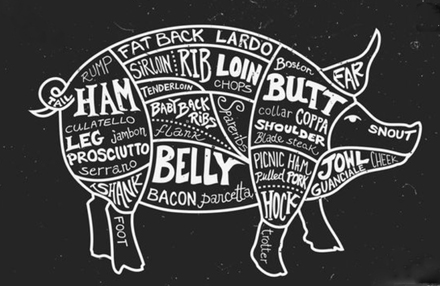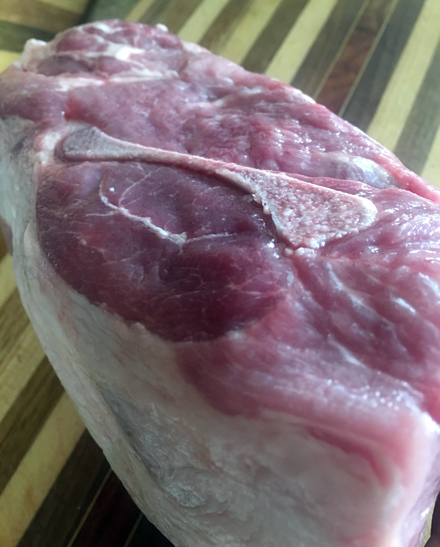shoulder or butt?
You may think from the title that this post is an update on my dad’s recent shoulder surgery. Or me updating you on the fact that he went down our staircase on his butt. That wasn’t the original intention, but I will give you that update first and then tell you all about the difference between pork shoulder and pork butt.
So … less than 48 hours after his rotator cuff surgery, my dad decided he should attempt coming down the stairs on his own. Not the best idea! While holding the rail with his left hand (not all the strong since his stroke a few decades back) and with his right arm in a sling, he slipped, hit his right side on the stairs, and slid down to the bottom on his behind.
I could wring his neck! We’d talked about the stairs the day before and I told him I didn’t want him on them without me, Dave, or Connor there to assist. Sunday morning, he decided he didn’t want to bother us, so down he went.
Monday, I took him in for x-rays, and thankfully, the shoulder is fine but he does have two broken ribs. Arrrg!!!! So we’ll be tacking on several more days is not weeks to his stay at the Hopkins’ Recuperating Home. OK, enough of that – on to the pork.
There is often confusion about the cuts of pork referred to as pork shoulder and pork butt. Pork shoulders, pork butts, and picnic “hams” are all part of the same front leg and shoulder of a hog.
What is commonly sold as a pork butt and Boston butt are the same cut of meat – the top portion of what is considered the “whole shoulder” of the hog. This cut is very marbled and often sold skinless, with a large portion of fat on top. The “butt” can be sold boneless or bone-in and weighs between 6 and 9 pounds on average for bone-in, or between 4 and 7 pounds if boneless. There is no need to search out the boneless variety. The bone, the blade, is thin and flat and not at all a nuisance, as you’ll see in the photos below.
In comparison, the pork shoulder is the lower portion of the shoulder. It is located below the joint and above the shank (leg). It is smaller than the pork butt and contains more fat, bone, and connective tissue. It is often sold complete with skin and is rarely sold boneless. This smaller roast usually weighs in at between 4 to 5 pounds.
The important thing to know is that no matter which cut you find in your market, all are interchangeable in any recipe (shredded pork or otherwise) that calls for pork shoulder or pork butt.
March 11, 2016 No Comments
spicy and sweet…yin and yang
Today I’m driving up to Flagstaff to deliver Connor back to NAU to finish his freshman year. I can not begin to believe it is already half over! So last night, the four of us had what will be our last family dinner all together for quite a few months. Dave had been craving ribs and since we haven’t had anything but traditional “American” or southwest foods recently, regular old barbecue was out of the question, Asian flavors fit the bill.
A couple of ingredients you may or may not be familiar with are Chinese five-spice powder and Sriracha Hot Chili Sauce. Chinese five-spice is a mixture of ground spices (cassia cinnamon, cloves, star anise, Szechwan peppercorns, and either ginger or fennel) that combine the five primary flavors of Chinese cuisine: sweet, salty, sour, bitter, and spicy (or pungent). This follows the Chinese philosophy of balancing the yin and yang in food. Works perfectly with my philosophy in food too; that it tastes great!
Sriracha Hot Chili Sauce (also known as “Rooster Sauce”) is a must-have for your pantry and is one of your best friends in the kitchen. There is really no need for me to wax poetic about its attributes and qualities since there is a fabulous article in this month’s issue of Bon Appétit, which will inform you more than you may ever need to know about “Rooster Sauce”. Click this LINK to read the article and see a bottle, so you know what to look for at the grocery store.
Plus this recipe works into our “easy-breezy” category, just be sure to plan ahead, 12 to 24 hours ahead, to allow the ribs to marinate and soak up all the great Asian flavors.
January 9, 2010 2 Comments
flank steak stir-fry
At one time, flank steak was considered to be a poor man’s meat, since the cut it considerably tougher than other cuts of beef. The cost of flank steak has risen considerably over the past 3 decades. In the 1970’s flank steak retailed for about 79 cents per pound, now it is well over $6 per pound, when not on sale. The cause? Fajitas! Once fajitas became popular, so did flank steak and strip steak. Both are very flavorful cuts and contain almost no fat. It is long, thin, and full of tough connective tissue. For these reasons, flank steak is usually marinated before being broiled or grilled whole. Because it is tough, you usually slice it thinly on a diagonal across or against the grain to sever the tough fibers and make the flavorful beef chewable. Flank steak is also used in stir-fry dishes as you will find with this quick and easy meal.
October 11, 2009 No Comments








